Servomotors / Servo Drivers
| Introduction | Features |
| Principles | Classifications |
| Engineering Data |
|
|
|
Troubleshooting |
What Is a Servomotor and What Is a Servo Drive?
A servomotor is a structural unit of a servo system and is used with a servo drive. The servomotor includes the motor that drives the load and a position detection component, such as an encoder.
The servo system vary the controlled amount, such as position, speed, or torque, according to the set target value (command value) to precisely control the machine operation.
Servo System Configuration Example

Features
Precise, High-speed Control
Servomotors excel at position and speed control.
Precise and flexible positioning is possible.
Servomotors do not stall even at high speeds. Deviations due to large external forces are corrected because encoders are used to monitor movement.
Fully-closed Loop
The most reliable form of closed loop. A fully-closed loop is used when high precision is required.
The motor is controlled while directly reading the position of the machine (workpiece or table) using a linear encoder and comparing the read position with the command value (target value). Therefore, there is no need to compensate for gear backlash between the motor and mechanical system, feed screw pitch error, or error due to feed screw torsion or expansion.
Fully-closed Loop System Configuration Example
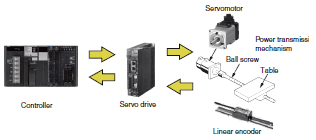
Semi-closed Loop
This method is commonly used in servo systems.
It is faster and has better positioning precision than an open loop.
Typically an encoder or other detector is attached behind the motor. The encoder detects the rotation angle of a feed screw (ball screw) and provides it as feedback of the machine (workpiece or table) travel position. This means that the position of the machine is not detected directly.
The characteristics depend on where the detector is installed.
| Installation location of detector | Behind motor | Motor side of feed screw | Opposite of motor side of feed screw |
| Gear backlash | Compensation required | Compensation not required | ← |
| Ball screw or nut torsion | Affected | ← | Hardly affected |
| Ball screw expansion or contraction | Affected | ← | ← |
| Ball screw pitch error | Compensation required | ← | ← |
Semi-closed Loop System Configuration Example
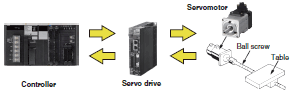
Open Loop
A stepper motor is used instead of a servomotor. There is no feedback loop.
The overall configuration is simple. Positioning can be performed at low cost, but gear and ball screw backlash and pitch errors cannot be compensated. When a stepper motor stalls, an error will occur between the command value and the actual movement. This error cannot be compensated.
Open loop control is suitable for low-precision, low-cost, lowspeed, and low-load-change applications.
Open Loop System Configuration Example

Principles
Servo Operation and Configuration
A system built with servo drives and servomotors controls motor operation in closed loop. The actual position, speed, or torque of the servomotor is fed back to compare to the command value and calculate the following errors between them. Then the servo drive corrects the operation of the servomotor in realtime using this error information to ensure that the system can achieve the required performance. This cycle of feedback, error detection, and correction is called closed-loop control.
The control loop is processed by either of servo drive or motion controller, or both depending on the required control.
The control loops for position, speed, and torque are independently used to achieve the required operation.
Applications will not always require all three control loops. In some applications, only the control loop for torque control will
be required. In other applications, current and speed for speed control are required, and in still other applications, three control loops for position control are required.
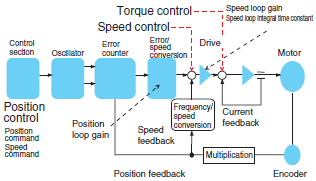
Servomotor
The most common types of industrial servomotors are those based on brushless motors. The rotor has a powerful permanent magnet. The stator is composed of multiple conductor coils, and the rotor spins when the coils are powered in the specified order. The movement of the rotor is determined by the stator’s frequency, phase, polarity, and current when the correct current is supplied to the stator coils at the appropriate time.
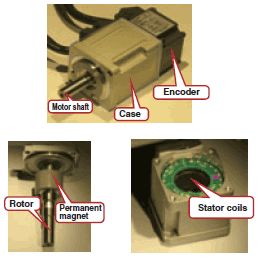
Encoder
Servomotors are different from typical motors in that they have encoders. This allows high-speed and high-precision control according to the given position and speed commands.
Encoders are one of the hardware elements that form the core of a servo system, and they generate speed and position feedback. In many cases, the encoder is built into the servomotor or attached to the servomotor. In certain applications, the encoder is an independent unit that is installed away from the servomotor. When the encoder is installed in a remote location, it is used for related parameters in addition to for control of servomotor operation.
Encoders are divided into two kinds.
Incremental encoders
Absolute encoders
Multi-turn absolute encoders are typically used for servomotors.
Refer to the Technical Explanation for Rotary Encoders for more information on encoders.
Servo Drive
Servo drives follow commands from the host controller and control the output torque, rotation speed, or position of motors.
The position, speed, or torque are controlled according to inputs from a motion controller, feedback encoder, and the servomotor itself, and the servo drive supplies the appropriate amounts of power to the servomotor at the appropriate times.
The basic operating principle is the same as for an inverter, in which the motor is operated by converting AC power to DC power to be a certain frequency.
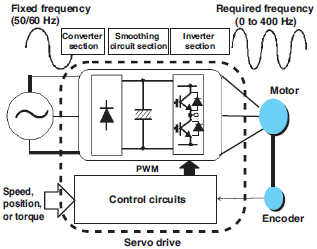
A servo drive also has the following functions.
Communications with the motion controller
Encoder feedback reading and realtime closed-loop control adjustment
I/O processing for safety components, mode inputs, and operating status output signals


